仁爱版七年级英语下册教案:U7T2SB教案
- 格式:doc
- 大小:40.50 KB
- 文档页数:6
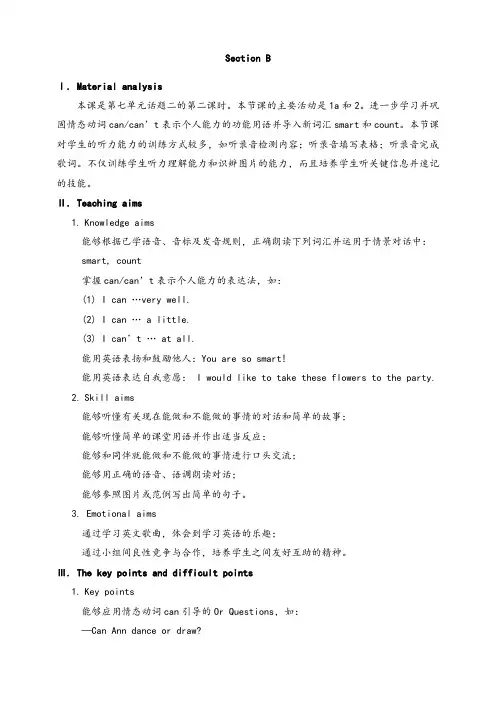
Section BⅠ. Material analysis本课是第七单元话题二的第二课时。
本节课的主要活动是1a和2。
进一步学习并巩固情态动词can/can’t表示个人能力的功能用语并导入新词汇smart和count。
本节课对学生的听力能力的训练方式较多,如听录音检测内容;听录音填写表格;听录音完成歌词。
不仅训练学生听力理解能力和识辨图片的能力,而且培养学生听关键信息并速记的技能。
Ⅱ. Teaching aims1.Knowledge aims能够根据已学语音、音标及发音规则,正确朗读下列词汇并运用于情景对话中:smart, count掌握can/can’t表示个人能力的表达法,如:(1) I can …very well.(2) I can … a little.(3) I can’t … at all.能用英语表扬和鼓励他人:You are so smart!能用英语表达自我意愿: I would like to take these flowers to the party.2.Skill aims能够听懂有关现在能做和不能做的事情的对话和简单的故事;能够听懂简单的课堂用语并作出适当反应;能够和同伴就能做和不能做的事情进行口头交流;能够用正确的语音、语调朗读对话;能够参照图片或范例写出简单的句子。
3. Emotional aims通过学习英文歌曲,体会到学习英语的乐趣;通过小组间良性竞争与合作,培养学生之间友好互助的精神。
Ⅲ. The key points and difficult points1.Key points能够应用情态动词can引导的Or Questions,如:—Can Ann dance or draw?—She can dance.能够用can/can’t表示能的有关程度,如:She can do it a little/very well.能够熟练使用表达自我意愿的表达方式。
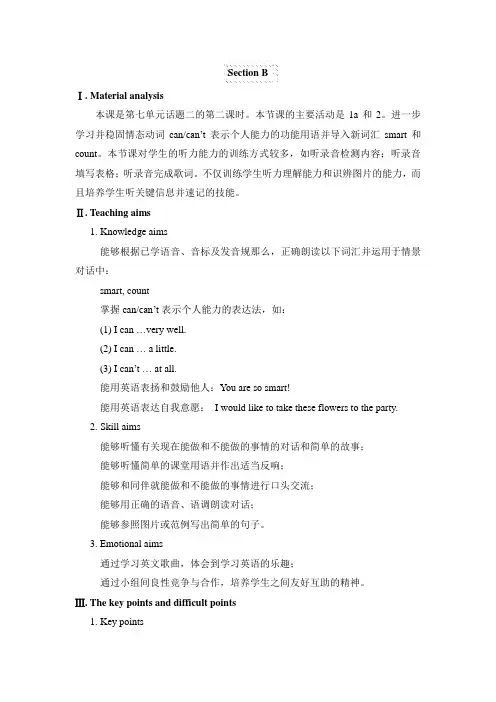
Section BⅠ. Material analysis本课是第七单元话题二的第二课时。
本节课的主要活动是1a和2。
进一步学习并稳固情态动词can/can’t表示个人能力的功能用语并导入新词汇smart和count。
本节课对学生的听力能力的训练方式较多,如听录音检测内容;听录音填写表格;听录音完成歌词。
不仅训练学生听力理解能力和识辨图片的能力,而且培养学生听关键信息并速记的技能。
Ⅱ. Teaching aims1.Knowledge aims能够根据已学语音、音标及发音规那么,正确朗读以下词汇并运用于情景对话中:smart, count掌握can/can’t表示个人能力的表达法,如:(1) I can …very well.(2) I can … a little.(3) I can’t … at all.能用英语表扬和鼓励他人:You are so smart!能用英语表达自我意愿:I would like to take these flowers to the party.2.Skill aims能够听懂有关现在能做和不能做的事情的对话和简单的故事;能够听懂简单的课堂用语并作出适当反响;能够和同伴就能做和不能做的事情进行口头交流;能够用正确的语音、语调朗读对话;能够参照图片或范例写出简单的句子。
3. Emotional aims通过学习英文歌曲,体会到学习英语的乐趣;通过小组间良性竞争与合作,培养学生之间友好互助的精神。
Ⅲ. The key points and difficult points1.Key points能够应用情态动词can引导的Or Questions,如:—Can Ann dance or draw—She can dance.能够用can/can’t表示能的有关程度,如:She can do it a little/very well.能够熟练使用表达自我意愿的表达方式。
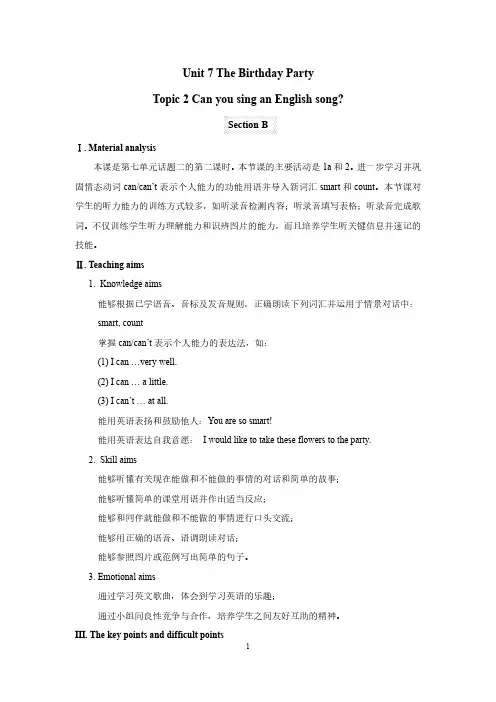
Unit7The Birthday PartyTopic2Can you sing an English song?Section BⅠ.Material analysis本课是第七单元话题二的第二课时。
本节课的主要活动是1a和2。
进一步学习并巩固情态动词can/can’t表示个人能力的功能用语并导入新词汇smart和count。
本节课对学生的听力能力的训练方式较多,如听录音检测内容;听录音填写表格;听录音完成歌词。
不仅训练学生听力理解能力和识辨图片的能力,而且培养学生听关键信息并速记的技能。
Ⅱ.Teaching aims1.Knowledge aims能够根据已学语音、音标及发音规则,正确朗读下列词汇并运用于情景对话中:smart,count掌握can/can’t表示个人能力的表达法,如:(1)I can…very well.(2)I can…a little.(3)I can’t…at all.能用英语表扬和鼓励他人:You are so smart!能用英语表达自我意愿:I would like to take these flowers to the party.2.Skill aims能够听懂有关现在能做和不能做的事情的对话和简单的故事;能够听懂简单的课堂用语并作出适当反应;能够和同伴就能做和不能做的事情进行口头交流;能够用正确的语音、语调朗读对话;能够参照图片或范例写出简单的句子。
3.Emotional aims通过学习英文歌曲,体会到学习英语的乐趣;通过小组间良性竞争与合作,培养学生之间友好互助的精神。
Ⅲ.The key points and difficult points1.Key points能够应用情态动词can引导的Or Questions,如:—Can Ann dance or draw?—She can dance.能够用can/can’t表示能的有关程度,如:She can do it a little/very well.能够熟练使用表达自我意愿的表达方式。

仁爱(科普版)英语七下《Unit 7 Topic 2 Can you sing an English song》教学设计2一. 教材分析教材为仁爱英语七下《Unit 7 Topic 2 Can you sing an English song》。
本课主要围绕歌曲展开,让学生学会欣赏英语歌曲,并能够简单介绍自己喜欢的歌曲。
通过本课的学习,学生能够提高听、说、唱的能力,培养对英语的兴趣。
二. 学情分析学生已经掌握了基本的英语语法和词汇,对听、说、读、写的能力有所提高。
但部分学生对英语歌曲感兴趣,部分学生对英语歌曲较为陌生。
因此,在教学过程中,需要关注学生的兴趣,激发他们的学习积极性。
三. 教学目标1.知识目标:学生能够听懂、会说、会唱本课的歌曲,掌握相关的词汇和句型。
2.能力目标:学生能够运用所学知识,介绍自己喜欢的歌曲,提高听、说、唱的能力。
3.情感目标:通过欣赏和演唱英语歌曲,培养学生的音乐素养,提高他们对英语的兴趣。
四. 教学重难点1.重点:学生能够听懂、会说、会唱本课的歌曲,掌握相关的词汇和句型。
2.难点:学生能够运用所学知识,介绍自己喜欢的歌曲,提高听、说、唱的能力。
五. 教学方法采用任务型教学法,通过听、说、唱、演等多种方式,激发学生的学习兴趣,提高他们的学习积极性。
同时,运用分组合作、互动交流等方法,培养学生的团队精神和沟通能力。
六. 教学准备1.教师准备:备好课件、教材、音响设备等。
2.学生准备:预习本课内容,熟悉歌曲。
七. 教学过程利用图片或实物,引导学生谈论他们喜欢的歌曲,激发学生的兴趣。
2.呈现(10分钟)播放本课的歌曲,让学生初步感受英语歌曲的魅力。
然后,教师逐句呈现歌词,引导学生跟读。
3.操练(15分钟)分组进行角色扮演,让学生模拟演唱歌曲,巩固所学知识。
期间,教师巡回指导,纠正发音等问题。
4.巩固(10分钟)设计一些听力练习,让学生听歌词,选择正确的答案。
同时,鼓励学生大胆开口,用英语描述自己喜欢的歌曲。
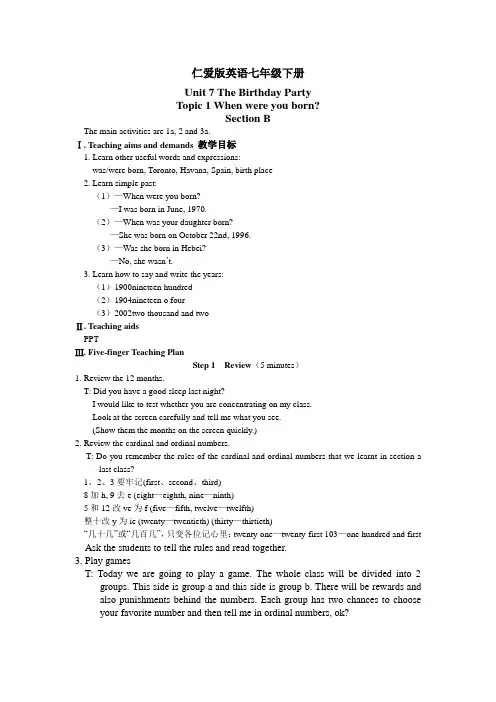
仁爱版英语七年级下册Unit 7 The Birthday PartyTopic 1 When were you born?Section BThe main activities are 1a, 2 and 3a.Ⅰ. Teaching aims and demands 教学目标1. Learn other useful words and expressions:was/were born, Toronto, Havana, Spain, birth place2. Learn simple past:(1)—When were you born?—I was born in June, 1970.(2)—When was your daughter born?—She was born on October 22nd, 1996.(3)—Was she born in Hebei?—No, she wasn’t.3. Learn how to say and write the years:(1)1900nineteen hundred(2)1904nineteen o four(3)2002two thousand and twoⅡ. Teaching aidsPPTⅢ. Five-finger Teaching PlanStep 1 Review(5 minutes)1. Review the 12 months.T: Did you have a good sleep last night?I would like to test whether you are concentrating on my class.Look at the screen carefully and tell me what you see.(Show them the months on the screen quickly.)2. Review the cardinal and ordinal numbers.T: Do you remember the rules of the cardinal and ordinal numbers that we learnt in section a last class?1、2、3要牢记(first、second、third)8加h, 9去e (eight—eighth, nine—ninth)5和12改ve为f (five—fifth, twelve—twelfth)整十改y为ie (twenty—twentieth) (thirty—thirtieth)“几十几”或“几百几”,只变各位记心里:twenty-one—twenty-first 103—one hundred and first Ask the students to tell the rules and read together.3. Play gamesT: Today we are going to play a game. The whole class will be divided into 2 groups. This side is group a and this side is group b. There will be rewards and also punishments behind the numbers. Each group has two chances to choose your favorite number and then tell me in ordinal numbers, ok?Step 2 Presentation(15minutes)1. T: I would like to know if you still remember how to express the date. So now group a pleaseask group b “What is the date?” and group b please answer the date I point.2. Learn the express of years in EnglishT: First, Let’s read these years.1900 nineteen hundred 1976 nineteen seventy-six 1904 nineteen o four2000 two thousand 2002 two thousand and twoExplain the constitution of the year: if it begin with the number smaller than 19, then we will divide it into 2 parts, except 1900, 1800 and so on. But if it is larger than 19, we will begin with 2000 and follow with the numbers behind.T: Now, say and write these years by yourselves. I’ll ask five students to write on the blackboard.1908 nineteen o eight 1989 nineteen eighty-nine 1996 nineteen ninety-six 2008 two thousand and eight 2050 two thousand and fifty3. Match the pictures with the dates.T: We write, "October 1st, 1949". But we say, "October first, nineteen forty-nine".T: We write, "20th December, 1999". But we say, "the twentieth of December, nineteen ninety-nine".T: I’ll ask some students to read these dates.4. Derive the expression of be bornName: Li Ming Age: 22 Birthday: August 11th Birthplace: GuangdongT: My name is Li Ming. I am thirty years old. My birthday is August eleventh. I was born in Fujian. be born 出生was(am, is的过去式)是T: What’s my name? S1: Your name is Li Ming.T: How old am I? S2: You are twenty.T: When is my birthday? S3: Your birthday is August 11th.T: Where was I born? S4: You were born in Guangdong。
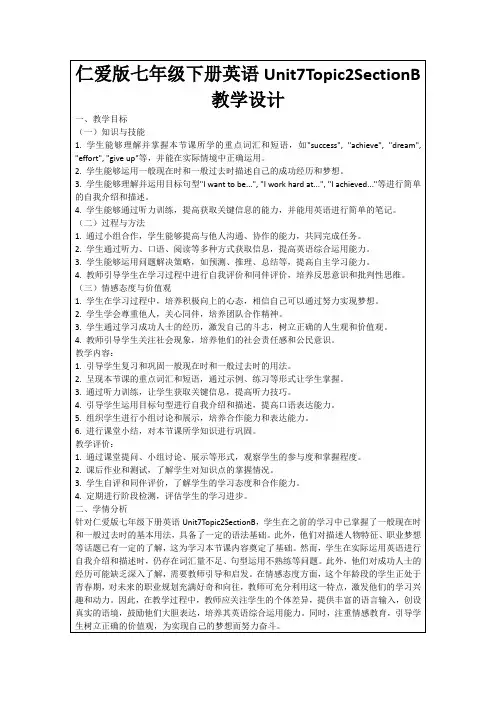
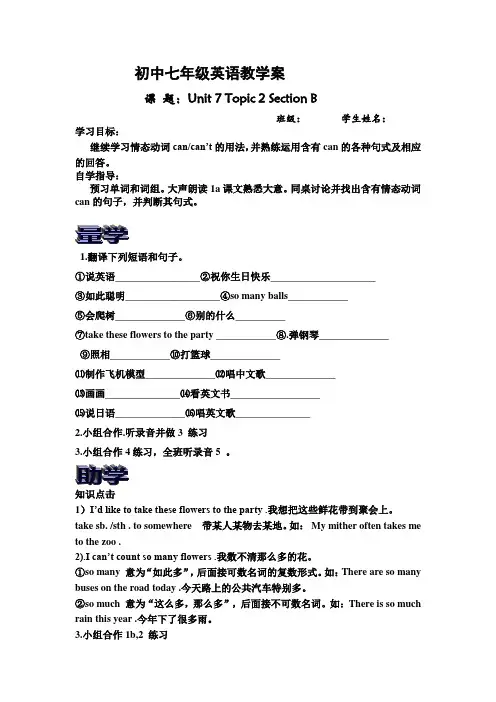
初中七年级英语教学案课题:Unit 7 Topic 2 Section B班级:学生姓名:学习目标:继续学习情态动词can/can’t的用法,并熟练运用含有can的各种句式及相应的回答。
自学指导:预习单词和词组。
大声朗读1a课文熟悉大意。
同桌讨论并找出含有情态动词can的句子,并判断其句式。
1.翻译下列短语和句子。
①说英语_________________②祝你生日快乐_____________________③如此聪明___________________④so many balls____________⑤会爬树______________⑥别的什么__________⑦take these flowers to the party ____________⑧.弹钢琴______________⑨照相____________⑩打篮球______________⑾制作飞机模型______________⑿唱中文歌______________⒀画画_______________⒁看英文书__________________⒂说日语______________⒃唱英文歌_______________2.小组合作.听录音并做3 练习3.小组合作4练习,全班听录音5 。
知识点击1)I’d like to take these flowers to the party .我想把这些鲜花带到聚会上。
take sb. /sth . to somewhere 带某人某物去某地。
如:My mither often takes me to the zoo .2).I can’t count so many flowers .我数不清那么多的花。
①so many 意为“如此多”,后面接可数名词的复数形式。
如:There are so many buses on the road today .今天路上的公共汽车特别多。
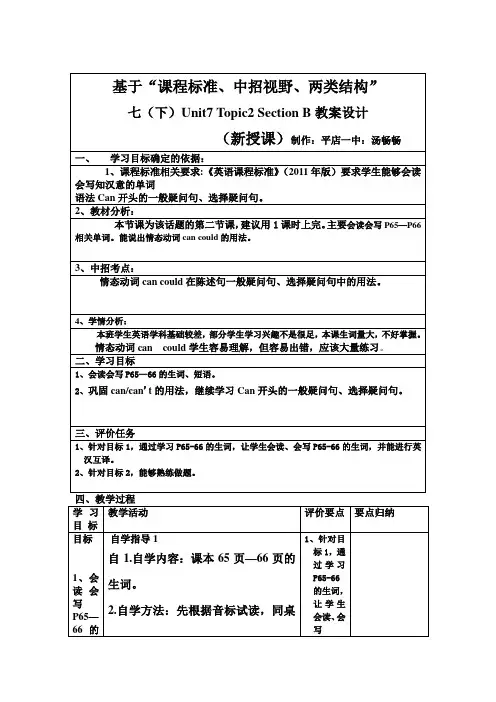
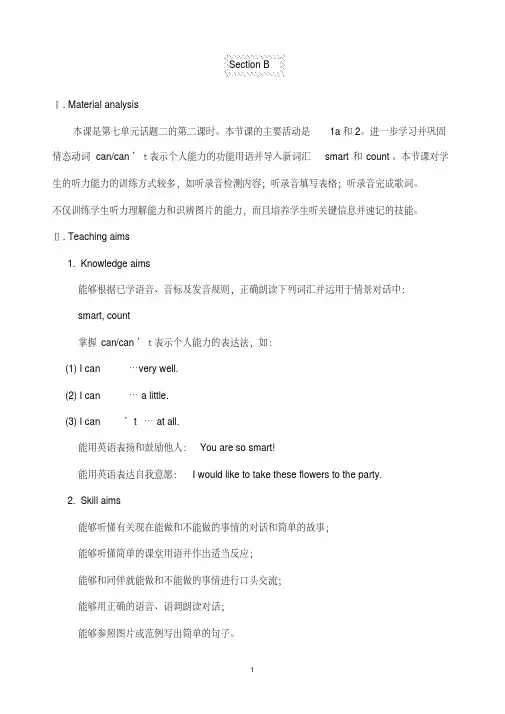
Section BⅠ. Material analysis本课是第七单元话题二的第二课时。
本节课的主要活动是1a和2。
进一步学习并巩固情态动词can/can’t表示个人能力的功能用语并导入新词汇smart和count。
本节课对学生的听力能力的训练方式较多,如听录音检测内容;听录音填写表格;听录音完成歌词。
不仅训练学生听力理解能力和识辨图片的能力,而且培养学生听关键信息并速记的技能。
Ⅱ. Teaching aims1.Knowledge aims能够根据已学语音、音标及发音规则,正确朗读下列词汇并运用于情景对话中:smart, count掌握can/can’t表示个人能力的表达法,如:(1) I can …very well.(2) I can … a little.(3) I can’t … at all.能用英语表扬和鼓励他人:You are so smart!能用英语表达自我意愿: I would like to take these flowers to the party.2.Skill aims能够听懂有关现在能做和不能做的事情的对话和简单的故事;能够听懂简单的课堂用语并作出适当反应;能够和同伴就能做和不能做的事情进行口头交流;能够用正确的语音、语调朗读对话;能够参照图片或范例写出简单的句子。
3. Emotional aims通过学习英文歌曲,体会到学习英语的乐趣;通过小组间良性竞争与合作,培养学生之间友好互助的精神。
Ⅲ. The key points and difficult points1.Key points能够应用情态动词can引导的Or Questions,如:—Can Ann dance or draw?—She can dance.能够用can/can’t表示能的有关程度,如:She can do it a little/very well.能够熟练使用表达自我意愿的表达方式。
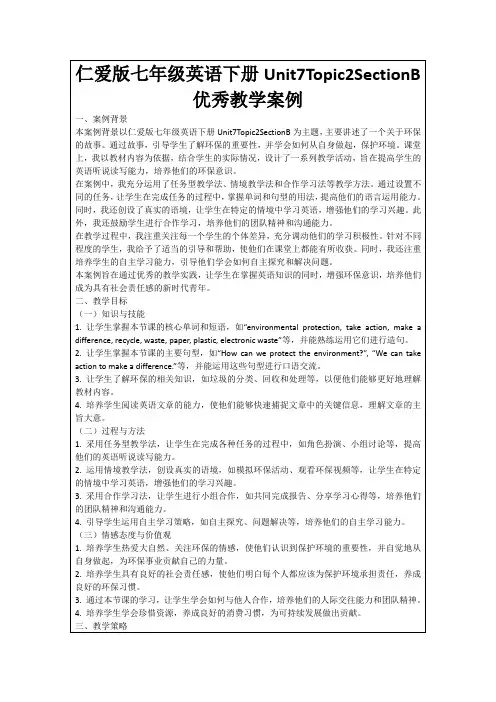

Unit7 Topic 2 Section B 说课稿一、说教材1.教材的地位和作用。
这次说课的内容为unit7topic2 Cooking is funsectionB.本话题为KangKang他们为美食节做准备,跟妈妈学做中餐之后又学习如何做西餐中的三明治和汉堡包,并引出外国的饮食习惯和餐桌礼仪。
对学生的情感教育在通过比较中西方饮食方面的差异,增进对西方国家的了解,提高他们对于英语的学习热情。
语法的重点为whether 和if 引导的宾语从句,还练习“to do”做逻辑主语的句型及副词的运用。
2.教学目标(知识、技能、情感)1、知识目标(knowkedge aims)learn some new words: snack,butter ,spread,pear,piece,pour;learn to know how to make sandwich2、能力目标(Ability aims)学习制作三明治,并用英语表达制作的顺序“first ,next ,then ….”继续学习whether 和if引导的宾语从句,同时复习比较级的用法3、情感目标(Emotional Aims)通过学习西餐的制作,了解外国饮食文化和餐桌礼仪,增进对西方国家的了解;从身边熟悉的事物说起,培养学生兴趣,敢于用英语表达.3、教学重点和难点学习如何用英语表达制作三明治,同时学会使用宾语从句二、说学情分析(1)初中学生的抽象思维能力较低,形象思维能力强,但注意力容易分散。
(2)学生经过一年多的学习,有了一定的英语基础知识和听说能力。
他们对英语学习还保持着较浓厚的兴趣,但词汇量和语法掌握不多。
(3)本课的主题是谈论饮食,都是学生熟悉的话题,因此容易引起学生的注意三、说教法学法●教法按照课程改革的要求,遵循“老师由主演变导演,学生由配角变主角”的角色转换,采用把课堂交给学生的教学理论,主要应用任务型教学法和情景交际法通过观察、思考、讨论、交流和合作等方式,在一种自然、真实或模拟真实的情境中体会语言、掌握语言的应用。
Section BⅠ. Material analysis本课是第七单元话题二的第二课时。
本节课的主要活动是1a和2。
进一步学习并巩固情态动词can/can’t表示个人能力的功能用语并导入新词汇smart和count。
本节课对学生的听力能力的训练方式较多,如听录音检测内容;听录音填写表格;听录音完成歌词。
不仅训练学生听力理解能力和识辨图片的能力,而且培养学生听关键信息并速记的技能。
Ⅱ. Teaching aims1.Knowledge aims能够根据已学语音、音标及发音规则,正确朗读下列词汇并运用于情景对话中:smart, count掌握can/can’t表示个人能力的表达法,如:(1) I can …very well.(2) I can … a little.(3) I can’t … at all.能用英语表扬和鼓励他人:You are so smart!能用英语表达自我意愿:I would like to take these flowers to the party.2.Skill aims能够听懂有关现在能做和不能做的事情的对话和简单的故事;能够听懂简单的课堂用语并作出适当反应;能够和同伴就能做和不能做的事情进行口头交流;能够用正确的语音、语调朗读对话;能够参照图片或范例写出简单的句子。
3. Emotional aims通过学习英文歌曲,体会到学习英语的乐趣;通过小组间良性竞争与合作,培养学生之间友好互助的精神。
Ⅲ. The key points and difficult points1.Key points能够应用情态动词can引导的Or Questions,如:—Can Ann dance or draw?—She can dance.能够用can/can’t表示能的有关程度,如:She can do it a little/very well.能够熟练使用表达自我意愿的表达方式。
2. Difficult points正确使用情态动词can引导的Or Questions。
Ⅳ. Learning strategies能在学习中善于利用图画等非语言信息帮助理解。
Ⅴ. Teaching aids教学图片、录音机、黑板和多媒体Ⅵ. Teaching proceduresStep InteractionpatternsStudent activity Teacher activityIntroduction (6 minutes) 1.The wholeclass work.2.The wholeclass workand individualwork.1.Focus theirattention on theteacher and singthe song together.2.Do 4. Try to fillin the blanks. Andsing the songtogether. Thenanswer thequestions:T:What can youdo?S1:I can ....T:Can you ...?S1:Yes, I can./No,1.Greet students and sing thesong that they have sung lastlesson.2.Play the tape and show thesong on the blackboard. Letstudents fill in the blanks andsing the song completely. Helpthe students revise theexpressions they’ve learnt lastclass.3.Individual work and pair work. I can’t.3.Look and guessthe picture. Talkabout your opinionabout the picturewith your partner.3.Show the picture in 1a andask the question: What canParrot do? Then let studentsguess the picture and say outtheir opinion about the picture.Presentation (15 minutes) 1.The wholeclass work.2.Individualwork.3.Group workand pair work.4.Pair work.1.Do 1a. Listen tothe tape carefullyand pay attentionto the sentences onthe blackboard.2.Do 1b. listen to1a and checkwhat Polly cando.3.Do 1c. Read thedialogue in pairsand act it out ingroups.4.Make up shortdialogs in pairs.Share yourdialogs with thewhole class.1.Play the tape and let studentslisten to the tape carefully.Point out the key sentences:You can speak English! Canyou sing an English song?What else can you do?... onthe blackboard and then letstudents pay attention to thesentences.2.Play the tape of 1a and helpstudents check the answers.3.To be a good listener.4.Give students 2 mins tomake up short dialogs in pairsand choose some pairs toshow their dialogs.Consolidation(8 minutes)1.Pair work.2.Pair work. 1.Do 2. Make upa conversationusing thepicture with theteacher:T: Can Ann danceor draw?S1:She can dance.She can do it alittle/ very well.T:What else canshe do?S1: She can drawa little.2.Make upconversationswith the otherthree pictures;Show yourconversations inpairs.1.Show the first picture in2.Make up a conversation withone student in pairs.2.Give students some time tomake up conversations withthe rest pictures; Choose somepairs to show theirconversations.Practice (10 minutes) 1.Individualwork.2.Individualwork.1.Do 3a. Answerthe questions: Yes,he/she can. No,he/she can’t.2.Listen andnumber thepictures byyourselves.1.Show the pictures in 3a andtalk about the pictures: Canhe/she...?Let students answerthe questions.2.Play the tape and let studentsnumber the pictures.3.The whole class work.4.Pair work. 3.Check theanswers of part Aand complete PartB; Check theanswers together.4.Do 3b. Do itwith partner;Practice yourdialogs to theclass.3.Play the tape again andcheck the answers about thepictures, then complete thetable in Part B; Check theanswers.4.Let students ask and answerquestions with the informationin 3b; Let some pairs show thedialogs.Production (6 minutes) Group work. Survey somestudents aboutwhat they can door can’t do, andthe degree of theability.S1: I can …S2: I can…S3: I can’t…S4: I can … verywell.S5:I can… a little.Then one studentin the groupwrites a shortpassage about thesurvey; And somestudents fromeach group give a1.To be a controller and helperin the task and make asummary about the task.report.2.Assign the homework:Review the expressions inSection B;Make new dialogs with thekey sentences orally;Preview 1a in Section C. Teaching reflection:本节课继续巩固选择疑问句的句型结构,在上节课的教学中,我们对本节课的学习做了铺垫,因此,教学效果相对较好;本节课重点训练了学生的听力技能,虽然训练方式较多,但是,要想提高学生的听力技能,还需经常练习。